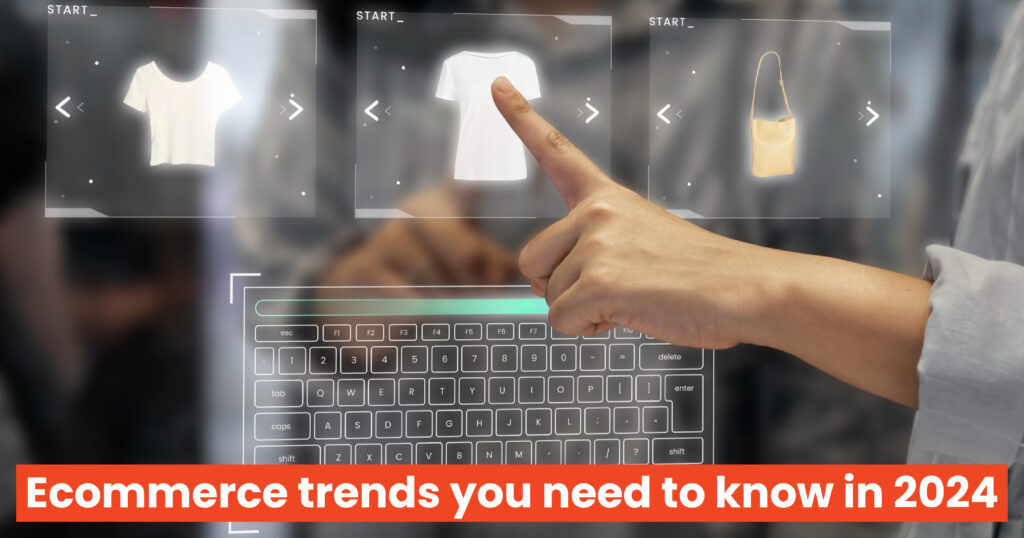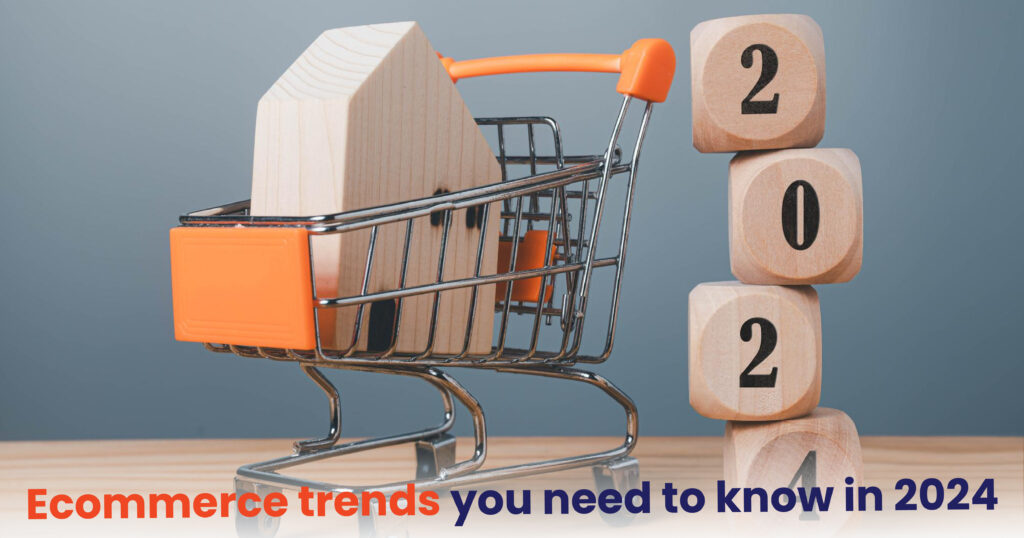
Ecommerce trends you need to know in 2024

The landscape of ecommerce is ever evolving, with each passing year bringing forth new technologies and consumer behaviours that reshape the industry. As we step into 2024, the world of online retail is poised for further transformation, driven by advancements in technology, shifting consumer preferences, and global market dynamics. In this blog post, we’ll explore the key ecommerce trends that are set to dominate in 2024.
Augmented Reality (AR) and Virtual Reality (VR) Shopping Experiences
One of the most exciting developments in ecommerce is the integration of augmented reality (AR) and virtual reality (VR) technologies to enhance the online shopping experience.
In 2024, we can expect more retailers to adopt AR and VR applications, allowing customers to virtually try on products before making a purchase. This immersive approach not only reduces the hesitation associated with online shopping but also provides a unique and engaging experience for consumers.
Artificial Intelligence (AI) and Machine Learning (ML) in Personalization
AI and ML technologies continue to play a pivotal role in ecommerce, particularly in the realm of personalization. In 2024, we anticipate a surge in the use of AI algorithms to analyse customer data and predict individual preferences.
Retailers will leverage this information to tailor product recommendations, optimize pricing strategies, and create personalized marketing campaigns. The result is a more customized and relevant shopping experience that fosters customer loyalty.
Voice Commerce on the Rise
The adoption of voice-activated devices is growing rapidly, and 2024 is likely to witness a significant uptick in voice commerce. As consumers become more comfortable with virtual assistants like Amazon’s Alexa and Google Assistant, ecommerce platforms will integrate voice-activated shopping features. Users will be able to search for products, place orders, and track deliveries using voice commands, making the shopping process more convenient and accessible.
Sustainability Takes Centre Stage
In recent years, there has been a notable shift in consumer attitudes towards sustainability. In 2024, ecommerce businesses are expected to place a greater emphasis on environmentally friendly practices.
From eco-friendly packaging to carbon-neutral shipping options, consumers will actively seek out retailers committed to reducing their environmental impact. Brands that embrace sustainability not only contribute to a better planet but also resonate more strongly with socially conscious consumers.
Blockchain for Enhanced Security and Transparency
As cybersecurity concerns continue to rise, the adoption of blockchain technology in ecommerce is set to increase. Blockchain offers a decentralized and secure way to manage transactions, protecting both consumers and businesses from fraud. Additionally, the transparent nature of blockchain ensures a verifiable supply chain, instilling trust in consumers regarding the authenticity and origin of products.
Social Commerce Integration
Social media platforms are evolving beyond just connecting people; they are becoming integral to the ecommerce experience. In 2024, social commerce is expected to witness significant growth, with platforms like Instagram, Facebook, and Pinterest enhancing their shopping functionalities.
Consumers will be able to discover and purchase products directly through social media, blurring the lines between socializing and shopping.
Subscription-Based Models and Loyalty Programs
Ecommerce businesses will continue to explore innovative ways to retain customers and build brand loyalty. Subscription-based models and loyalty programs will become more prevalent, offering customers exclusive perks, personalized experiences, and automatic product replenishment. These strategies not only incentivize repeat purchases but also foster a sense of community around the brand.
Contactless Payments and Seamless Checkout Experiences
The demand for contactless transactions will continue to rise, pushing ecommerce platforms to prioritize seamless and secure checkout experiences. Integrating various payment options, including digital wallets and buy now, pay later (BNPL) services, will become a norm. -Streamlining the checkout process enhances customer satisfaction and encourages higher conversion rates.
Personalized Customer Support through Chatbots and AI
AI-driven chatbots will play an increasingly significant role in providing personalized customer support. Ecommerce platforms will implement chatbots that use AI to understand customer queries, offering tailored assistance and recommendations.
Real-time, personalized support enhances customer engagement and contributes to a positive overall shopping experience.
Dynamic Pricing Strategies and Flash Sales
Ecommerce retailers will leverage dynamic pricing algorithms to adjust product prices in real-time based on factors such as demand, competitor pricing, and inventory levels. Flash sales and time-limited promotions will become more prevalent, creating a sense of urgency and driving immediate customer action. Dynamic pricing and flash sales contribute to a dynamic and engaging online shopping environment, encouraging frequent visits to ecommerce platforms.
Conclusion
As we navigate the dynamic landscape of ecommerce in 2024, these trends are poised to redefine the way we shop online. From immersive technologies like AR and VR to the growing importance of sustainability, businesses that stay ahead of the curve will be better positioned to meet the evolving needs and expectations of consumers.
Embracing these trends is not just about keeping up with the times; it’s about creating a seamless, personalized, and delightful shopping experience in the digital age.






Responses